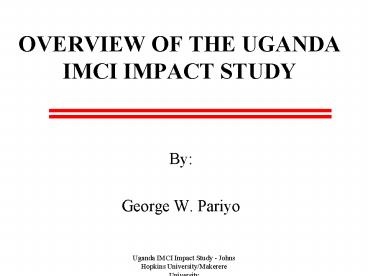OVERVIEW OF THE UGANDA IMCI IMPACT STUDY - PowerPoint PPT Presentation
1 / 37
Title:
OVERVIEW OF THE UGANDA IMCI IMPACT STUDY
Description:
Heavy expenditure on IMCI by countries and donors. For all these resources, what is really ... 7.6% Children slept Under a net. 8.8% Nets had ever been treated ... – PowerPoint PPT presentation
Number of Views:47
Avg rating:3.0/5.0
Title: OVERVIEW OF THE UGANDA IMCI IMPACT STUDY
1
OVERVIEW OF THE UGANDA IMCI IMPACT STUDY
- By
- George W. Pariyo
2
Why evaluate IMCI?
- Heavy expenditure on IMCI by countries and donors
- For all these resources, what is really being
achieved? - What are the results?
- Do health workers really improve their
performance? - Do households change health seeking behaviour?
- Is IMCI too complex for developing country health
systems? - Is IMCI a valid use of funds, given so many
priorities? - or could we get more results investing in
other things?
3
Which should be evaluated?
- How is IMCI being Implemented?
- National, district, health facility, community
- Is IMCI changing behaviour?
- Health worker performance
- Household management of illness
- Health system support of IMCI
- Is the burden of disease being affected?
- Lessening illness
- Reducing deaths
4
How to evaluate?What should we measure?
- We can evaluate--
- implementation Inputs and process
- change in behaviour Outcomes
- Change in death rates Impact
Increasingly complex study methods needed
5
IMCI multicountry evaluation
- Multi-country evaluation (MCE) studiesWHO
coordination - Tanzania, Bangladesh, Peru, Bolivia, Kazakhstan
(WHO) - Uganda (USAID)
- Mainly implementation and behaviour change
studies - Each country looking at different aspects
- The Uganda study was designed to measure
mortality changes - Changes in mortality are the ultimate test of
effectiveness of a child health activity - This is the Bottom Line or the Gold Standard
6
Uganda IMCI Impact Study
- Objectives of the Uganda Study
- 1. Document impact of IMCI introduction on child
mortality - 2. Document change in process and outcome
indicators in health facilities (NGO public),
communities and households as a result of IMCI - 3. determine opportunity costs (next best uses)
of human resources equipment and finances needed
for IMCI and determine if greater good could be
achieved if resources had been used differently. - Implemented by a partnership between Johns
Hopkins and Makerere Universities, in
collaboration with the Ministry of Health
7
Study Design
- Baseline DHS
- IMCI implementation continuously monitored in 10
districts - Health worker traininghealth worker performance
- Health system strengthening---district program
support - Community component---household behaviour
- When IMCI implementation felt adequate to affect
child mortality - DHS repeated to determine mortality change (
other indicators) - Determining this adequacy an important issue
8
Uganda IMCI Impact study design
9
Study Populations
- Sampling frame
- 6 IMCI districts randomly selected (1999)
- From a list of districts ready for implementation
of IMCI - and which had adequate support to sustain IMCI
- 4 comparison districts matched
- Districts without active plans to implement IMCI
(1999)
10
HEALTH SEEKING BEHAVIOUR
11
(No Transcript)
12
Mosquito net Use
- 7.6 Children slept Under a net
- 8.8 Nets had ever been treated
- On average nets had been last treated 1 month ago
(range 1month to 3 years)
13
(No Transcript)
14
(No Transcript)
15
Home management for Diarrhoea
16
Management of Fever at Home
17
(No Transcript)
18
Closest facility 83, Average duration of
travel to HF 15 minutes
19
Reasons for not going for referral
- No money 76.5
- No transport 12.5
- No permission from HH head 6.3
- Other 0.1
20
COSTING COMPONENT
21
Summary of Costs of Seeking Health Care (Data
from 10 districts 1 US 1,500/)
22
Transport
23
Conclusions
- Household costs of seeking care are high.
- Although most people walk to health facilities,
transport and lodging still account for a
relatively high proportion of household costs of
seeking health care. - There is wide variation in the costs of seeking
health care and therefore cost information should
take into account geographical and income
information.
24
HEALTH FACILITY SURVEY PRELIMINARY RESULTS (8
DISTRICTS)
25
If child had cough or difficulty breathing
Checks Respiratory Rateplt0.001 OR 4.4
26
If child had diarrhoea Health worker checks
for dehydrationplt0.001 OR 7.45
27
Checks weight against growth cardplt0.001 OR 7.65
28
Child referred when appropriatep0.003 3.53
29
Gives correct feeding instructionsplt0.001 OR 2.91
30
General Observations
- Low utilisation is a problem
- Large proportion of children still managed by HW
not trained in IMCI - IMCI case management algorithm not followed
strictly by the trained HW - Most facilities have 1st line drugs, but lack 2nd
line pre-referral treatment drugs - Essential items like Chart booklets, laminated
forms and mothers cards are lacking in many
facilities
31
INFANT AND CHILD MORTALITY
32
LEVELS AND TRENDS IN INFANT CHILD MORTALITY
33
Infant mortality rates by 5-year periods
preceding the survey
34
Child mortality rates by 5-year periods preceding
the survey
35
Key Mortality Determinants
- Female babies experience lower mortality than
male babies - Babies born to younger mothers (lt40) experience
higher mortality than those born to older mothers
(40)
36
Determinants Contd.
- First order births are at the highest risk of
death, followed by 7 birth orders - The lowest mortality risk is among birth orders 2
- 3
37
Determinants Contd.
- Children born to mothers with at least secondary
education enjoy the best survival probability - Children born to mothers with no education are at
the highest risk of death































